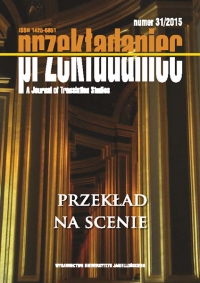Życie to sen: Calderón w nowej odsłonie
Life Is a Dream: A New Take on Calderón
Author(s): Marta Eloy CichockaSubject(s): Translation Studies
Published by: Wydawnictwo Uniwersytetu Jagiellońskiego
Keywords: Pedro Calderón; Life Is a Dream; translation; adaptation; translating verse
Summary/Abstract: Life Is a Dream (2013) – a new translation into Polish of La vida es sueño by Pedro Calderón de la Barca, the theatrical masterpiece of the Spanish Golden Age – was commissioned by the Teatr Współczesny in Szczecin for director Wojciech Klemm. The translation and adaptation of Life Is a Dream by the Kraków-based scholar in Iberian studies and poet Marta Eloy Cichocka is the latest in a series of Polish translations of Calderón: the first to be undertaken in the 21st century, and the second to be penned by a woman. In the 19th century the text of La vida es sueño was tackled by Ryszard Berwiński, Edward Dembowski, Wiktoryn Doleżan, Leon Rudkiewicz, Józef Szujski and Adam Tomasz Chłędowski (who entitled his translation Władysław [sic!], królewic polski, czyli Życie snem (1826), i.e. Władysław [sic!], Prince of Poland, or, Life Is a Dream – giving up the Germanic name Segismundo which appears in the original work). A century later the play was translated by Barbara Zan, but Polish readers best know the stylised translation of Edward Boyé and its contemporary rendering by Jarosław Marek Rymkiewicz. Pedro Calderón de la Barca called his play La vida es sueño, meaning simply Life Is a Dream. After lengthy discussions, it is this title which for the translator seemed most appropriate, the closest to the original and the most natural sounding. A new title may signal to the readers that they are dealing with Calderón in a new translation in which the polymetre of the original has been exchanged by a combination of blank verse and prose. Paradoxically, resigning from rhyme one gains access to many meanings which are lost in the process of translating verse, where the stiff corset of rhyme often yokes the translator into restricting the sense of the statement being made. Apart from the aforementioned issues, the article touches upon the problems of the functional fidelity of the translation of theatrical masterpieces, the loyalty of the translator in relation to the author and the director, as well as the oft-problematic decisions concerning adaptability in the context of the Polish reality surrounding theatrical renderings.
Journal: Przekładaniec.
- Issue Year: 2015
- Issue No: 31
- Page Range: 182-200
- Page Count: 11
- Language: Polish

